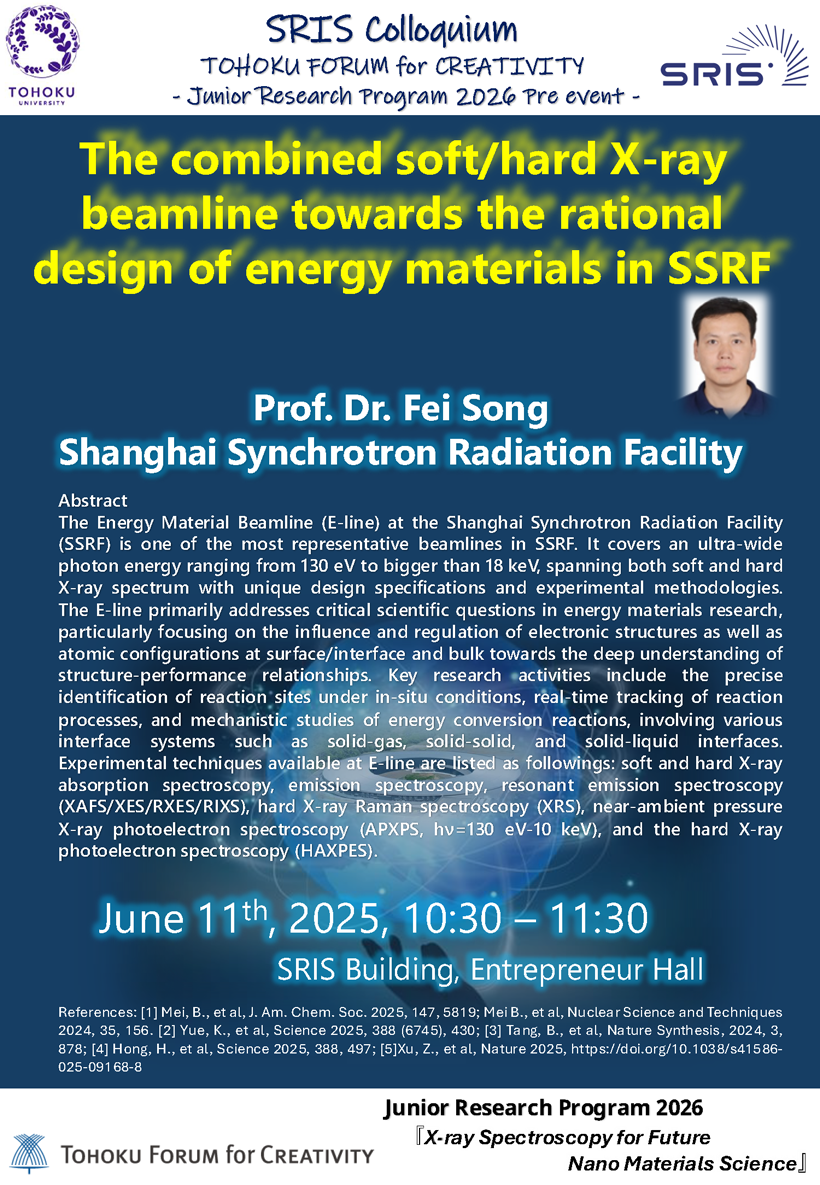Information
This seminar serves as a pre–event for the Junior Research Program 2026 “X–ray Spectroscopy for Future Nano Materials Science” which will be organized in 2026 by International Center for Synchrotron Radiation Innovation Smart, Tohoku University.
Date
Wednesday, June 11, 2025, 10:30 – 11:30
Venue
SRIS Building, Entrepreneur Hall, Aobayama New Campus, Tohoku University [Access]
Hosted by
International Center for Synchrotron Radiation Innovation Smart, Tohoku University
Tohoku Forum for Creativity, Organization for Research Promotion, Tohoku University
Speaker
Fei Song (Shanghai Synchrotron Radiation Facility)
Time Schedule
- 10:30 – 11:30
- Fei Song (Shanghai Synchrotron Radiation Facility)
- The combined soft/hard X–ray beamline towards the rational design of energy materials in SSRF
Abstract
The Energy Material Beamline (E–line) at the Shanghai Synchrotron Radiation Facility (SSRF) is one of the most representative beamlines in SSRF. It covers an ultra–wide photon energy ranging from 130 eV to bigger than 18 keV, spanning both soft and hard X–ray spectrum with unique design specifications and experimental methodologies. The E–line primarily addresses critical scientific questions in energy materials research, particularly focusing on the influence and regulation of electronic structures as well as atomic configurations at surface/interface and bulk towards the deep understanding of structure–performance relationships. Key research activities include the precise identification of reaction sites under in–situ conditions, real–time tracking of reaction processes, and mechanistic studies of energy conversion reactions, involving various interface systems such as solid–gas, solid–solid, and solid–liquid interfaces. Experimental techniques available at E–line are listed as followings: soft and hard X–ray absorption spectroscopy, emission spectroscopy, resonant emission spectroscopy (XAFS/XES/RXES/RIXS), hard X–ray Raman spectroscopy (XRS), near–ambient pressure X–ray photoelectron spectroscopy (APXPS, hν=130 eV–10 keV), and the hard X–ray photoelectron spectroscopy (HAXPES).
References: [1] Mei, B., et al, J. Am. Chem. Soc. 2025, 147, 5819; Mei B., et al, Nuclear Science and Techniques 2024, 35, 156. [2] Yue, K., et al, Science 2025, 388 (6745), 430; [3] Tang, B., et al, Nature Synthesis, 2024, 3, 878; [4] Hong, H., et al, Science 2025, 388, 497; [5]Xu, Z., et al, Nature 2025, https://doi.org/10.1038/s41586–025–09168–8
Poster
- Download [PDF]
